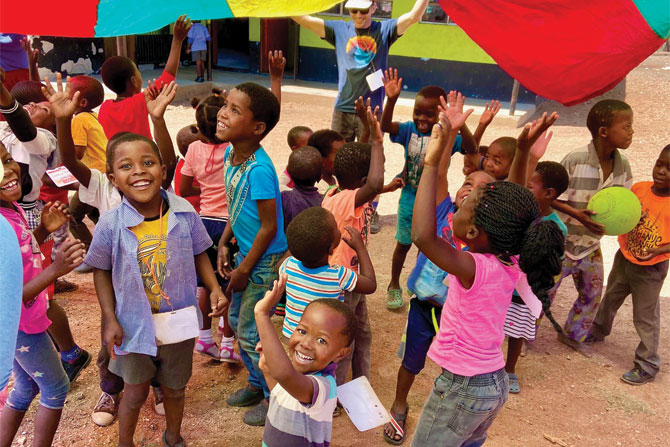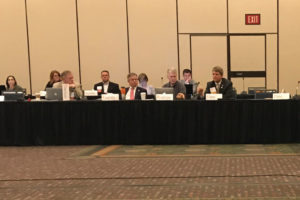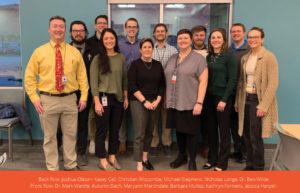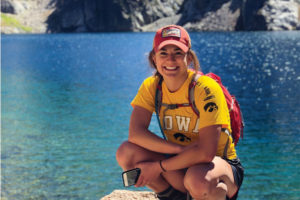By UAFP
In the fall of 2019, Dr. Erin McAdams and Dr. Zachary Fredman worked with other medical professionals to plan a two-day medical conference. They had assessed the educational needs of their audience, researched evidence-based information, and prepared informative and topical presentations. What made this medical conference very different from most, however, was that it took two days and over 10,000 miles to get there — because this conference was held in a small southern African country called Eswatini.
Adventures in Missions
In the early 2000s, Matt and Carike Gerber, a couple living in South Africa, became aware of some of the significant challenges facing the people in what was then Swaziland. The Gerbers wanted to find a way to assist the communities there that complimented the efforts already in place. What they learned was that groups of local women had set up informal resource points on plots of lands throughout the country to provide meals to children. The women were not paid for this service. They saw it as their duty to the community. Matt and Carike worked with the community members to formalize the plots of land that would come to be known as “Care Points.” The Gerbers’ objective was to provide support on the backend to ensure that food would be available for the women to prepare and provide to the children. While the Care Points initially served only a few hundred children, they now provide meals to over 7,500 children from around the country. As the Care Points interacted with more and more children as an organization, they looked to offer more asset-based development and empower children with skills applicable to life in their communities. The organization provides a discipleship training, pays for school fees so children can get their primary education, and one meal a day, five days out of the week.
The Gerbers formalized their efforts into two mission-based organizations; Children’s Hope Chest, a stateside organization with a fundraising and administrative focus, and Adventures in Missions (AIM), which recruits and trains individuals who work on the ground in the communities they partner with. Many of the people employed by AIM in Eswatini are born and raised in the community where they serve.
Over the years of building relationships with local community members, the mission group saw a burgeoning need to try and address some of the medical concerns in the area. What they had discovered through their partnership was that you could not meet a community’s basic needs and ignore their health.
The Capitol Church Connection
Shortly after Dr. McAdams began her residency with the University of Utah, she also started attending Capital Church in Salt Lake City. She learned that the church had developed a longstanding partnership in Eswatini with members of a community through a missionary organization. A church group had been making a trip once or twice annually for about nine years with the missionary group. Together, they provided support and resources to communities that were struggling with access to basic needs. Members of Capital Church had been approached because the congregation happens to have several members with medical training. Volunteers were asked if they were interested in providing basic medical training and screening exams for community members who did not otherwise have easy access to care and basic health education. McAdams was always interested in global health and had gone on other medical service-related trips. This particular venture interested her because the group already had a longstanding relationship with the community. Also, the request for assistance was coming from the local community members instead of an outside group making Western-based assumptions about the community’s needs. The goal was to provide medical education to leaders who would then share the information with the larger community, making the education and access to information more sustainable in the community. She has since led annual medically-education focused trips for the last four years to Eswatini through this partnership.
Challenges and Opportunities for the Youth of Eswatini
One of the biggest challenges faced by the people of Eswatini is their high rate of community members who are HIV positive. Approximately 27% of those ages 15-49 in Eswatini are HIV positive. This percentage is the highest rate of infection of any country in the world. A large swath of the middle generation is missing because parents have died or abandoned their children. This situation results in a family structure where many grandparents are taking care of large groups of grandchildren. These family units might have one parent still present, but rarely both. Unfortunately, the public education system is lacking as well, which has left many children in the country without basic resources such as food and education. The support provided by the Care Points has become critical to the wellness of the children in Eswatini.
The children who grow up in the Care Point system can apply to work in a leadership position known as a “shepherd,” when they have aged out of high school. The position is a paid partnership with AIM and includes one year of leadership training in South Africa. Those accepted into leadership positions are required to work for a Care Point for two years following the year of training. Shepherds act as adult role models and teachers and help to hold children utilizing the Care Points accountable. This leadership role serves as a valuable transitional role for young adults in their late teens and early 20s.
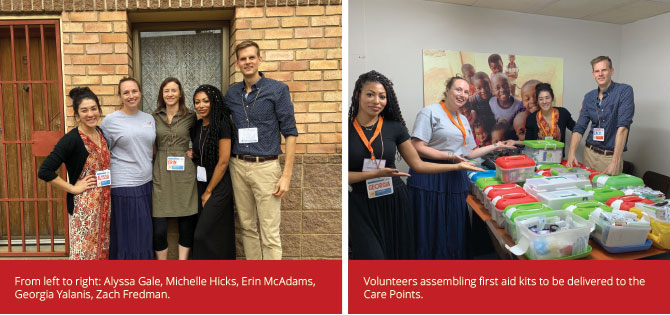
Training the Trainers
Over the years, the shepherds have asked to learn information on several topics, including health-related subjects such as:
- Complications of HIV
- Learning more about tuberculosis and other types
of pneumonia - Treating skin infections
- Signs of asthma exacerbations
- What causes diarrhea and how to treat it
- Determining who is sick enough to need more intensive medical care
They also have questions about depression and mental health because these are not often spoken about in their community. There are also concerns about identifying and managing domestic violence. The mission group tries to provide these young adults didactic and hands-on training for themselves and their families so that they can better care for the children in the community. The training has been very well-received and is now mandated for shepherds to attend. During these trips, medically-trained volunteers also perform some basic screening for leaders to help direct their care. McAdams has been able to recruit many nurses and physical therapists to come on previous trips but would like to recruit more physicians for future trips as well. Last year she was excited to have a fellow physician, Zachary Fredman, join her.
Dr. Fredman grew up in Litchfield, Minnesota, and attended medical school at the University of Minnesota. As a student, he did a rural rotation in New Ulm, which has a population of about 13,500. Since he was the only medical student there, he had opportunities more akin to what a resident would experience. This experience served him well on his trip to Eswatini, which he says was very similar to his work in a rural community, “just with a lot fewer resources.” Fredman started attending Capital Church after moving to Utah to begin his family medicine residency with the University of Utah, which is where he first heard about the mission trip from McAdams. They were looking for physicians to accompany the group because the community’s educational needs had grown over the years.
For this trip, the main objective of the medical team was to hold a small medical conference where leaders from all the Care Points throughout the country would attend. The leaders had been asked in advance which subjects they wanted to learn about. Fredman presented information on how to properly care for snake bites, seizures and the stigma sometimes associated with them, and puberty development and sexual maturity. He provided sex education to both the shepherds and a separate group of 10- to 18-year-olds. He started with very basic anatomy and then covered maturity, intercourse and consent. With the high rate of HIV in the country, community members needed more comprehensive sex education, including information about circumcision, condoms, other protection and abstinence.
While not the primary purpose of the trip, the medical volunteers also took some time with leaders to perform some basic medical screenings, addressing concerns ranging from dry eyes to much more complex questions dealing with anxiety and depression and socioeconomic conditions.
Personal Impact
For Fredman, the biggest takeaway from his experience is the reminder that when visiting an underdeveloped country, guests need to ask the people who live there what they would benefit from the most and then try and provide those resources and education. While potentially more difficult, it is more beneficial to provide education that they can pass on to others in the community.
One of the most rewarding aspects of this partnership, according to McAdams, is building relationships with the community over several years — developing a trust with the people you are working with. Over time, McAdams says seeing a measurable, objective improvement in the community allows her to feel like she is part of a partnership. She wants to continue to support the community in whatever way she can and is grateful they see knowledge about health as an important part of their growth as a community. McAdams says, “Your words have more weight, and people are more willing to adapt when you build a relationship because they realize it’s in their long-term best interests.”
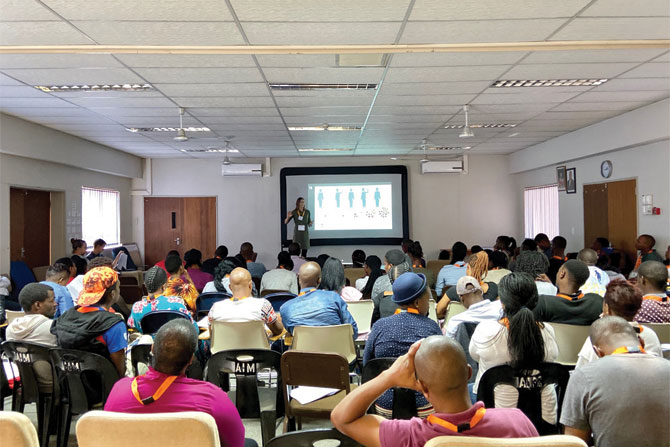
Dr. Erin McAdams is an assistant professor, clinical, in the Department of Family and Preventive Medicine at the University of Utah. She’s originally from Indiana and lives in Salt Lake City with her husband. She enjoys being active in the outdoors and playing sports, traveling and reading.
Dr. Zach Fredman is a third-year Family Medicine resident at the University of Utah, originally from Minnesota. He enjoys being outside, hiking, skiing and playing sports. He also spends his time reading and cooking.
By UAFP
This story appears in Issue 1 2020 of the UAFP Journal.

